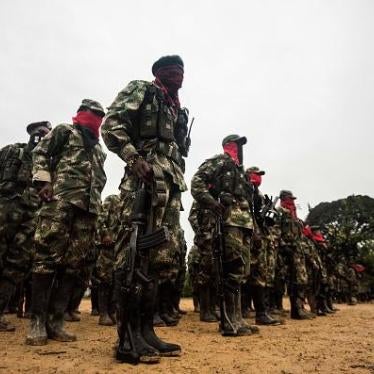This article is the second in a series by Human Rights Watch to mark the 10 years since the Soacha cases.
Between 2002 and 2008, army brigades across Colombia systematically murdered more than 3,000 civilians. The bodies were recorded as enemies killed in combat, in what came to be known as “false positive” cases.
As investigations of the killings moved forward, many soldiers told prosecutors that pressure on troops to report results in combat —and rewards for killings—were a perverse incentive behind the false positives. Human Rights Watch has now uncovered military documents that describe in-depth how the twisted incentives worked.
The military assessed commanders for the most part based on the number of kills reported by their troops. An April 2006 military document we found proves it. It is called “Policies of Gen. Mario Montoya,” who was the army chief from 2006 through 2008.
The document emphasizes that “commanders are evaluated based on their results.” It goes on to define “results” bluntly: “Kills are not the most important issue, they are the only issue.”
The “campaign plan” for 2007 through 2010 of the 7th division, one of seven Army divisions at the time, notes that its units will be assessed, first, by the number of enemy kills, second, by the extent to which terrorist attacks in its area decrease, and, finally, by how many of its troops are killed (see document). A commander in the 30th brigade in March 2006 summed up the policy this way: “the policy of the commander of the army is to kill, we are at war” (see document).
Senior officers in this era created tables in which they periodically ranked divisions, brigades, and battalions according to results. The tables referred to the number of enemy troops killed or captured—or who surrendered. Yet the rankings were based largely on the number of kills. So, in July 2006, for example, the 7th division was ranked highest, reporting 379 kills, 285 enemies captured and 32 who voluntarily surrendered. The fifth division was ranked seventh, although it reported many more enemies captured, 671, and surrendered, 105. It reported only 67 kills (see document). We found similar patterns in many other rankings.
At least in some cases, the number of kills was compared from year to year. For example, a 7th division document from March 2007 mentions that its 4th brigade’s results were “very low” because the unit had achieved “minus 71 kills compared to 2006” (see document). The document, signed by General Luis Roberto Pico Hernandez, then commander of the 7th division, breaks it down further, noting that the 32th infantry battalion of the 4th brigade had achieved “minus 17 kills in combat” compared to the previous year (see document).
So, what could commanders expect, based on such assessments?
If they didn’t report enough kills, the consequence was clear: they could lose their jobs. General Montoya was emphatic about that in a radio broadcast we found, from February 2006: “if there is a commander who doesn’t report kills, there are 250 lieutenant colonels waiting in line [to replace him]” (see document).
Conversely, commanders and soldiers who reported kills could receive juicy benefits, including:
- Money. In a military logbook from the 30th brigade, for example, we found minutes of a broadcast on March 1, 2006, establishing monetary incentives: “from now on, commanders from all units will be ranked based on kills… a unit that reports 6 kills or more in a sole operation [gets] 30,000,000 pesos” (see document). In another 30th brigade military logbook of April 2006, an officer establishes “for a kill, $2,000,000 pesos [if the enemy has] a rifle” (see document.) And from there, he establishes a scale: “[we will pay] $500,000 [if he has] a pistol and [we] will pay $300,000,000 for killing six enemies or more” (see document).
- Days off. For example, in August 2007, General Montoya told commanders: “[every] unit that engages in combat and achieves good results must have days off. We need to motivate the troops” (see document). Several radiograms—telegrams sent by radio—that we reviewed showed soldiers—and entire units—granted days off after reporting kills. A unit was granted 20 days off, for example, “due to the kill of a ‘no name’ person who apparently belonged to squad 35 of the FARC.”
- Commissions abroad. In a 7th division document we reviewed, for example, a colonel proposes assigning 9 soldiers to a Colombian battalion on duty in the Sinai Peninsula of Egypt. An annotation by each soldier’s name indicates how many kills the soldier has reported.
- Awards. A directive we revealed last year, apparently from 2003 or 2004, establishes a “body count” to determine when soldiers can obtain a “distinguished service award.” Under the policy, brigade commanders, for example, were required to report at least 150 enemy combatants killed and 500 captured.
- Congratulations. We have reviewed various citations congratulating soldiers and officers who reported kills. For example, in June 2007, the commander of the 7th division congratulated Lieutenant Colonel Luis Fernando Borja Aristizabal and other soldiers for killing “some terrorists.” Borja Artistizabal was later convicted for over a dozen false positives committed between 2007 and 2008.
The evidence corroborates the vicious policy behind the “false positive” killings. But will commanders ever be held accountable for their role in these atrocious crimes?







